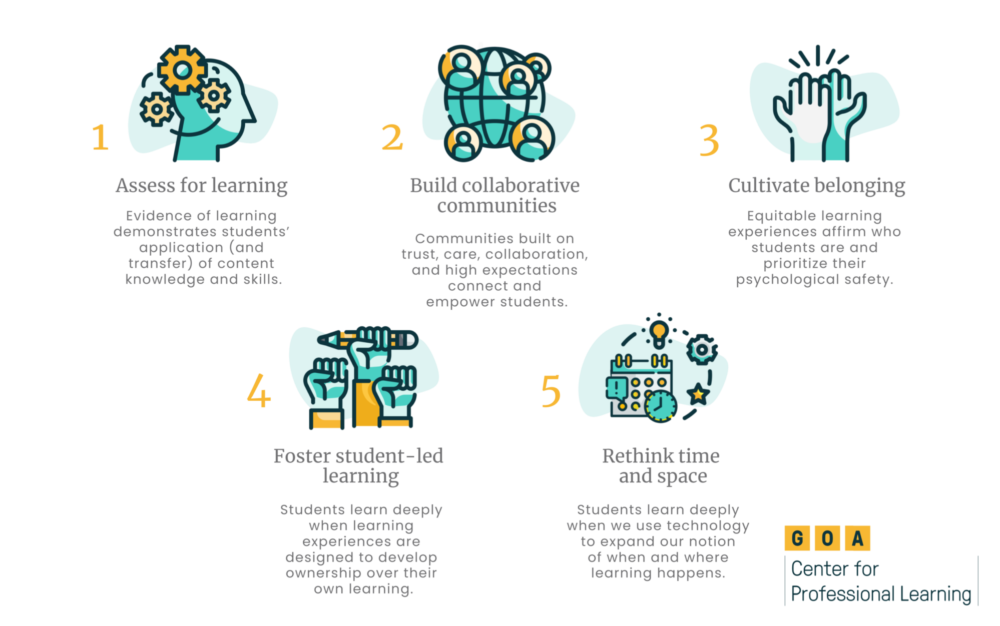Looking Ahead: Why Relationships Must Drive School Innovation
Last year, I was wrong when I wrote that “2021 is the year we will—we must—act on what 2020 revealed to us about why education matters and how it needs to improve.” It turns out that what schools needed to do was to address the many challenges that Covid brought - social distancing and testing policies, remote learning, demographic shifts, equity challenges, and teacher burnout. What we’ve seen and heard from schools since then has been a need to focus on rebuilding relationships and strengthening community, not on program innovation or rethinking norms. That was the right decision. Relationships come first. Always.
But here we are, facing the reality that some of the changes and shifts that schools made in response to the pandemic, (more flexible scheduling, increased communication with parents and guardians, inclusion initiatives and policies, pedagogical shifts, equitable grading practices, etc.) are here to stay.
Schools have a habit of wanting to continually innovate by introducing new ideas and methodologies, rather than strategizing on how to make previous innovations as effective and impactful as possible. It’s a blessing and curse as we need new ideas, and yet there’s a saturation point for what teachers and students can handle that schools often surpass. While there is still a deep need to focus on strategy over innovation, as schools emerge from the confines of Covid and eventually from this pandemic, educators and schools need to reflect on what they learned over the past two+ years and what those learnings might mean for how schools change moving forward. And, it will be critical that schools consider how to keep relationships at the forefront of those decisions.
The Student Perspective
I recently listened to a panel of students from one of our member schools reflect on the past two years of school. They talked a lot about what they learned and they focused specifically on the skills they gained. One thing that was clear in their reflections is that learning for them is relational no matter what the platform. Whether online or on-campus, students want to connect. They want to be seen, heard, and cared for.
Connecting with Students and Building Belonging
Jacob Crowder, teacher at GOA and Brookstone School
As school communities, we need to acknowledge that, although challenging at times, the level of resiliency and adaptability shown by students and teachers is truly astounding and something we should all be proud of. These teenagers offered great suggestions and insights, and it’s important that we take a look at school through their viewpoint and see what we might learn. This isn’t to say that there wasn’t a lot lost by not being on campus, which is absolutely where we want the majority of our students’ time to be spent when it comes to school, but when we ask students to reflect on their experiences it’s important that we not frame every question around loss, and begin to focus on some of what was learned, practiced, and gained.
So, what did students feel that they learned over the last two years that we should pay close attention to? These students’ lists included the following:
Increased self-advocacy skills
Improved written communication skills
They learned to be more flexible and adaptable as they managed a plethora of changes both large and small
When they worked from home, they learned to manage distractions while also learning the importance of self-care such as knowing when they needed to take breaks, get exercise, reach out to an adult for support, etc.
Improved time-management skills
Increased comfort with technological tools and resources to support their learning.
When asked about what schools could change and improve to make the school experience better, their list included:
Increased mental health support and resources
More flexibility in their schedules
Better monitoring of homework load amongst teachers
More proactive support from school systems
Increased diversity among the student body
Improved grading policies
When school leaders consider what to adapt and adopt and what to eschew, they should consider the perspectives of their students who have a lot of insight to offer. And, the decisions schools make should emphasize the importance of relationship-based learning experiences. The equation is simple: caring adults + engaged students = high quality learning experiences!
Clarity is Caring
In order to attract and retain the best teachers, schools must answer the question, “what does it mean to be a learning institution, not just for students, but for our entire school community?” Just as many schools have had to articulate what the value-add is of their programs by measuring student learning and growth through competencies, we’re going to see the same goal apply to faculty as well.
Through Portraits of a Graduate, schools created a shared vision of excellence that everyone in the school could work toward. Similarly, a shared vision for faculty, a Portrait of an Educator, will help to focus the types of learning experiences and resources that will guide their faculty as they develop the skills and competencies needed to successfully fulfill the mission of their school.

GOA’s educator competencies articulate the skills educators need to have to teach in order to improve student learning outcomes, regardless of where or who they teach, or where they are in their own professional development.
Take the use of technology tools with younger students as an example. We will never take these tools away from students now that they’ve been exposed to them. Teachers have been trying new tools as they move between in-person and remote learning, and in many cases the solutions they’ve implemented have aided learning and created opportunities for students to engage with school in new ways. Not just by attending school via Zoom, but by engaging with their work through platforms that allow them to express their ideas, to find resources they may not have found in class, and to share their learning through a variety of tools and platforms. The floor for what kids need to know and be able to do has been raised, which means teachers need to know how to best leverage these new tools and technologies. To do that, school leaders need to support their faculty by providing the right training, resources, and support. Clarity around what the expectations are for integrating technology into the classroom can be made explicit by naming it as a competency all teachers in that school need to demonstrate mastery in.
These shared goals that provide meaning and clarity around teachers’ work will also be critical in retaining faculty over time. The entire workforce is facing hiring and retention issues and schools will be impacted as well. According to surveys conducted by NAIS, 44% of participating independent schools reported increased faculty turnover. Coupled with a Washington Post/Rand Corp survey that found one in four educators is thinking about leaving the profession, we are facing a potential crisis.
Teachers want opportunities to learn and grow, and they want to know what’s expected of them. This can be achieved through a clear articulation of the skills schools expect teachers to develop combined with a robust professional learning plan that supports them in acquiring and practicing those skills. The result will mean more uniform and improved assessment practices; better implementation of technology in the classroom through increased training and clearer school expectations and goals; improved faculty wellness and decreased burnout; and improved education training programs as schools are clearer about the types of skills they need their faculty to demonstrate.
To do this, schools need to be responsive institutions. We can’t ask everyone around us to change if we’re not willing to change ourselves. When a faculty member is learning and growing, they need to know that they’re re-entering a school that has also evolved and is ready to adapt, too. Too often we see teachers asked or prodded by school administrators to learn something new, but then to apply those new skills within a system that can’t support those changes.
In order to support those changes administrators, too, need to skill-up. Middle leaders in schools need to shore up their skills to support the teachers and students in their schools. Conflict resolution, project management, public speaking, written communication, meeting facilitation, and time management are just some of the skills leaders need to practice and hone to effectively lead. To do that, we’re going to see an increase in leadership coaching and structured mentoring programs to ensure that the development of these skills isn’t just happening via happenstance, but because administrators are proactively working on and developing them.
A Culture of Care
The final piece of all this is that we remember why we work in schools in the first place, which is because we care about children. Students need to know that we care about them, and making sure that we demonstrate that through our actions and the decisions we make is something that schools, administrators, and teachers need to remember every day. So, while there’s a lot here about setting clear expectations and goals, setting up systems and structures, and measuring performance and progress, at the end of the day what we strive for in our work comes down to finding the joy in what we do. As school leaders, we need to create a place where students can find joy in learning, and teachers can find joy, growth, and purpose in the critically important work that they do.
Want to get involved with GOA? To learn with us, visit our professional learning course catalog, explore our consulting and design services, or inquire about becoming a member school.

